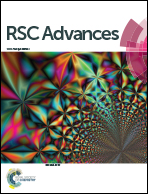Structure–property relationship in fluorene-based polymer films obtained by electropolymerization of 4,4′-(9-fluorenylidene)-dianiline
Abstract
The electrochemical deposition method has been used as an appropriate tool for preparing ultrathin films of fluorene-based polymers for applications in electroluminescent devices. Thus, for the first time, electropolymerization by consecutive multisweep cyclic voltammetry (CV) of 4,4′-(9-fluorenylidene)-dianiline (FDA) in dichloromethane solution containing 0.1 M tetrabutylammonium hexafluorophosphate as supporting electrolyte on an indium tin oxide (ITO)-coated glass slides is reported. To modulate the structure of the resulting polymer films and to better understand the mechanism of the electrogrowth process, the electropolymerization process was carried out in two potential domains, 0–1.3 V and 0–2 V. The changes in the courses of the electropolymerization waves in the two ranges are discussed and compared. FTIR spectroscopy was employed to solve problems concerning the monomer linkage in the polymer films obtained under the two different conditions. The properties of the obtained layers were evaluated in terms of structure morphology, optical properties, and electrochemical behavior. Different morphologies were found for these smooth and very thin films that prove to have the ability for blue light-emission and hole-injection and transport (p-doping). An electropolymerization mechanism similar to that of polyaniline is proposed and discussed on the basis of the obtained experimental data.


 Please wait while we load your content...
Please wait while we load your content...